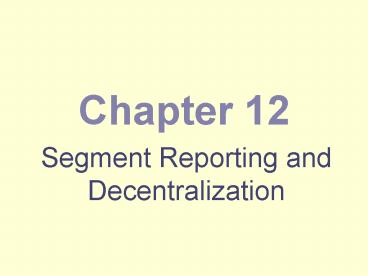Segment Reporting and Decentralization - PowerPoint PPT Presentation
1 / 24
Title:
Segment Reporting and Decentralization
Description:
Regal Company reports the following: Net operating income $ 30,000 ... Regal's manager was able to increase sales to $600,000 which increased net ... – PowerPoint PPT presentation
Number of Views:200
Avg rating:3.0/5.0
Title: Segment Reporting and Decentralization
1
Segment Reporting and Decentralization
Chapter 12
2
Decentralization in Organizations
Benefits of Decentralization
Top management freed to concentrate on strategy.
Lower-level managers gain experience
in decision-making.
Decision-making authority leads to job
satisfaction.
Lower-level decision often based on better
information.
Improves ability to evaluate managers.
3
Decentralization in Organizations
May be a lack of coordination among autonomous man
agers.
Lower-level managers may make decisions without
seeing the big picture.
Disadvantages of Decentralization
Lower-level managers objectives may not be those
of the organization.
May be difficult to spread innovative ideas in
the organization.
4
Decentralization and Segment Reporting
- A segment is any part or activity of an
organization about which a manager seeks cost,
revenue, or profit data. A segment can be a - Cost Center - A segment whose manager has control
over costs, but not over revenues or investment
funds - Profit Center - A segment whose manager has
control over both costs and revenues, but no
control over investment funds - Investment Center - A segment whose manager has
control over costs, revenues, and investments in
operating assets
5
Fixed Costs
- Traceable costs would disappear over time if the
segment itself disappeared. - Common costs arise because of overall operation
of the company and are not due to the existence
of a particular segment - Do not allocate common costs in evaluating the
performance of segments
6
Levels of Segmented Statements
Common costs should not be allocated to the
divisions. These costs would remain even if one
of the divisions were eliminated.
7
Traceable Costs Can Become Common Costs
Of the 90,000 cost directly traced to the
Television Division, 45,000 is traceable to
Regular and 35,000 traceable to Big Screen
product lines.
8
Hindrances to Proper Cost Assignment
The Problems
9
Allocations of Common Costs
10
Allocations of Common Costs
11
Allocation of Common Costs
12
Return on Investment (ROI) Formula
Income before interest and taxes (EBIT)
Cash, accounts receivable, inventory, plant and
equipment, and other productive assets.
13
Return on Investment (ROI) Formula
- Regal Company reports the following
- Net operating income 30,000
- Average operating assets 200,000
- Sales
500,000
14
Return on Investment (ROI) Formula
15
Return on Investment (ROI) Formula
16
Controlling the Rate of Return
- Three ways to increase ROI increase sales,
reduce expenses, reduce operating assets - Regals manager was able to increase sales to
600,000 which increased net operating income to
42,000. - There was no change in the average operating
assets of the segment.
Lets calculate the new ROI.
17
Return on Investment (ROI) Formula
18
Criticisms of ROI
19
Criticisms of ROI
- As division manager at Winston, Inc., your
compensation package includes a salary plus bonus
based on your divisions ROI -- the higher your
ROI, the bigger your bonus. - The company requires an ROI of 15 on all new
investments -- your division has been producing
an ROI of 30. - You have an opportunity to invest in a new
project that will produce an ROI of 25.
As division manager would you invest in this
project?
20
Residual Income Another measure of performance
- Net operating income above some minimum
- return on operating assets
- Residual income encourages managers to make
profitable investments that would be rejected by
managers using ROI - A division of Zepher, Inc. has average operating
assets of 100,000 and is required to earn a
return of 20 on these assets. - In the current period, the division earns 30,000.
21
Residual Income
22
Appendix 12A Transfer Pricing
- Transfer price price charged for products
transferred between divisions of the same company - Seller Division A
- Production capacity per month 10,000 barrels
- Variable cost per barrel - 8
- Fixed costs per month - 70,000
- Selling price to outside customers - 20 per
barrel - Buyer Division B
- Usual purchase price - 18 per barrel
- Monthly purchase 2,000 barrels
23
Transfer Pricing
- Sellers minimum transfer price
- Variable cost Lost contribution margin from
outside sales/number of units transferred - Buyers maximum transfer price
- Cost of buying from outside supplier
- Seller has idle capacity can sell 2,000 barrels
to buyer - Seller will accept proposal if transfer price
is gt 8 0/2,000 8 - Buyer will accept proposal if transfer price lt
18 - Transfer price range - 8 to 18
24
Transfer Pricing
- Seller has no idle capacity can sell 2,000
barrels to outside customer for 20 per barrel - Seller will accept proposal if transfer price is
gt 8 (20-8)2,000/2,000 20 - Buyer will accept proposal if transfer price is
lt 18 - No transfer should take place let seller sell to
outside market for 20 let buyer buy at 18 per
unit. - Seller has some idle capacity can sell 1,000
barrels internally buyer has to buy all 2,000
barrels from same source - Seller will accept proposal if transfer price is
gt 8 (20-8)1,000/2,000 14 - Buyer will accept proposal if transfer price is lt
18 - Transfer price range - 14 - 18































